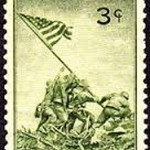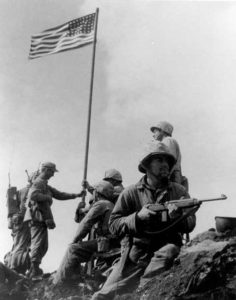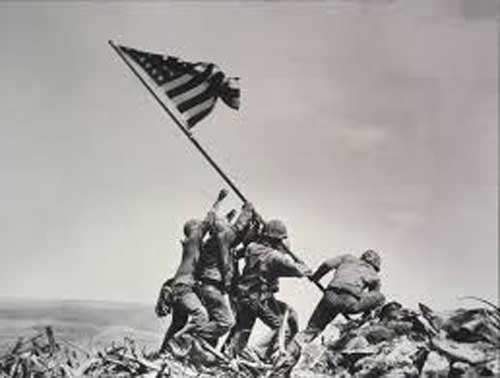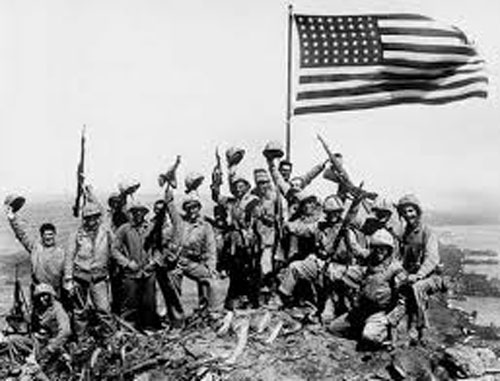 Iwo Jima! Staged?
Iwo Jima! Staged?
Six soldiers raised the flag, photographer Joe Rosenthal took his shot, his photo quickly became a phenomenon – and he was accused of staging the whole thing.
Rosenthal fuelled the rumor-mill himself

After bitter fighting, American G.I.s raised the Stars and Stripes on Mt Suribachi on February 23, 1945. Then they did it again.
The first flag-raising (left) was photographed by Sgt Louis Lowery (1916-87). He was a founder and past president of the Marine Corps Combat Correspondents Association and photographic director of the Marine Corps magazine Leatherneck.
October 17, 2019: The U.S. Marine Corps issued new information concerning the identity of the soldiers raising the flag. More information, and the full press release, is here.
The first flag was too small – it was barely visible from Iwo’s beaches – so it was replaced with a larger flag, attached to a water pipe. This larger flag, which had been retrieved from a landing craft, did the trick: the Stars and Stripes was now clearly visible atop the 550-foot mountain, and marines on the beach cheered when they saw it.
Two days later the photo appeared in many Sunday newspapers in America, and soon it was familiar in Europe as well. That same year, Rosenthal (1911-2006) was awarded the Pulitzer Prize for Photography.

More Keystone Kops than Otto Preminger
He almost missed the shot entirely. When the Marines started raising the flag, Rosenthal – far from directing the action like a Hollywood director – had placed his camera on the ground so that he could erect a good platform. Suddenly aware that the event was proceeding without him, he lunged for his Speed Graphic and took some shots in the nick of time.
Also photographing the scene was Rosenthal’s boss at Associated Press, Sgt. Bill Genaust, using a motion-picture camera. Genaust was killed in action at Iwo two weeks later.
After the flag was raised, Rosenthal took pictures of a larger group of marines at the site. It was this picture which caused all the trouble.
Two flags, one too many photos
Soon after he left Iwo, Rosenthal was asked if he had staged the photo, and he admitted that, yes, he had. But he thought that the question referred to the obviously posed group shot, not the flag raising.

His admission was innocent, but the damage was done. And once done, it spread. Rosenthal was even accused of assembling his six soldiers after the flag had actually been raised.
Rosenthal repeatedly provided the correct explanation over the years, one that was corroborated by Genaust’s movie film. The rumors nevertheless refused to go away and persist even today. The Pulitzer Prize website contains Rosenthal’s own explanation which he provided only two weeks after the flag-raising. He also paid warm tribute to the entire Marine Corps:
The Marine history will record Iwo Jima as high as any in their many gallant actions in the Pacific. I have two very vivid memories: The fury of their D-day assault and the thrill of that lofty flag-raising episode. It is hard now in the quiet atmosphere of this advance base to find words for it. The Marines at Iwo Jima were magnificent.
Immediately upon his arrival in Washington, D.C. on April 19, Hayes noticed the incorrect identification in the photograph. When he was interviewed about the identities in the photo by the Marine colonel assigned to the flag-raisers and told him that it was definitely Harlon Block and not Hansen in the photograph, the public relations officer then told Hayes that the identifications had already been officially released, and ordered Hayes to keep silent about it